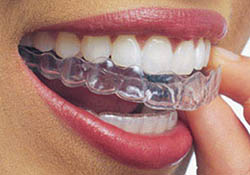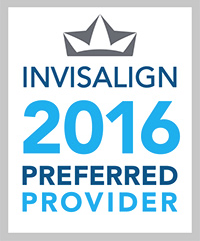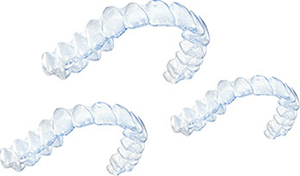 We want to make you smile.
We want to make you smile.INVISALIGN TAKES A MODERN APPROACH TO STRAIGHTENING TEETH.

 Your Invisalign treatment will consist of a series of aligners that you switch out about every two weeks. Each aligner is individually manufactured with exact calculations to gradually shift your teeth into place. And since your Invisalign system is custom-made for your teeth and your teeth only, with a plan devised by you and your dentist or orthodontist, you know you'll end up with a smile that truly fits.
Your Invisalign treatment will consist of a series of aligners that you switch out about every two weeks. Each aligner is individually manufactured with exact calculations to gradually shift your teeth into place. And since your Invisalign system is custom-made for your teeth and your teeth only, with a plan devised by you and your dentist or orthodontist, you know you'll end up with a smile that truly fits.
If you're ready for a smile that transforms your appearance, Invisalign is your answer. Although there are many choices out there, no other works as effortlessly as the Invisalign system.
Invisalign is the best way to transform your smile without interfering with your day-to-day life.
Check out the benefits below:
What is Invisalign?

You may be somewhat familiar with how the Invisalign® treatment works, but we’d like to take you through each step of the treatment process, from consultation to confident smile. Whether you’re considering treatment for yourself or someone else, knowing more about the entire process can help you be more confident in your decision to choose Invisalign and enjoy a better smile every day.

1.
Talk to an Invisalign Provider
Your treatment begins after you select the experienced Invisalign-trained Provider that you feel most comfortable with and schedule your initial consultation. Because you will be interacting with this doctor on a regular basis, you may even want to personally meet with a few providers before deciding which one is right for you. This is an important medical and financial decision. That's why choosing the right doctor and the right treatment plan is so essential. Keep in mind that not all dentists and orthodontists work with Invisalign, so it's important to find a doctor who has received the proper Invisalign training and can truly evaluate your needs and determine how Invisalign can help you.
2.
A Customized Treatment Plan is Created for You
During the consultation, you and your doctor will discuss your case in detail to determine if you're a good candidate for Invisalign. Invisalign now addresses many cases, from simple to more complex. Your doctor will determine if Invisalign is right for you. (Take the Smile Assessment ahead of time to see if you might be a good candidate.) This will also be your opportunity to ask any questions about Invisalign, costs , dental/orthodontic insurance, or any other concerns. See which doctors in your area are Invisalign Providers.
Your doctor will take x-rays, pictures and impressions of your teeth, which Invisalign will use to create a digital 3-D image of them. From these images your doctor will map out a precise treatment plan, including the exact movements of your teeth, and tell you the approximate length of treatment. Using the same technology your doctor will be able to show you a virtual representation of how your teeth will move with each stage of treatment. While every case is unique to each patient, treatment typically takes approximately a year for adults. For teens the length of treatments is comparable to that of braces.
3.
Receive Your Custom Aligners Based On
Your Personalized Treatment Plan

Based on your individual treatment plan, a series of custom-made, clear aligners is then created specifically for you. These aligners are made of a smooth, comfortable, BPA-free plastic that won't irritate your cheeks and gums like traditional metal braces often do. Simply wear them throughout the day, and remove them when you eat or to brush and floss your teeth. As you wear each set of aligners, your teeth gently and gradually begin to shift into place. And because they're virtually invisible, most people won't even notice you're wearing them.
4.
Wear a New Aligner Every Two Weeks
Approximately every two weeks, you will begin wearing a new set of aligners, advancing you to the next stage of your treatment. To monitor your progress, you will also have occasional checkups with your doctor, usually only every six weeks or so. For best results and a timely outcome, you should wear your aligners for 20 to 22 hours per day, throughout your entire treatment. At every stage, you will be able to see how much closer you are to having the smile that reflects the real you.
5.
Reveal Your New Smile & Keep It Looking Great
Congratulations! This is the time when you celebrate. You have reached the end of treatment and you will be smiling more than ever.
© invisalign.com 2015
Will It Work For Me?

Not only is Invisalign versatile, helping to correct a broad range of dental and orthodontic issues, but it really works. And there are over half a million smiles to back that up. But a confident smile isn't the only benefit of correcting your dental issues with custom-made Invisalign aligners—your health can be positively impacted as well. Learn more about several common issues below that an experienced Invisalign doctor can work with you to correct.
Overly crowded teeth:
This occurs when there is simply a lack of room within your jaw for all of your teeth to fit normally. When left untreated, overly crowded teeth can cause dental decay, an increase in chances of gum disease, and can prevent the normal function of teeth.
Widely spaced teeth:
This occurs with abnormal continued growth of the jaw bone. When teeth are missing, this issue can also be caused by the other teeth shifting due to extra space. Spacing issues in teeth can cause some periodontal diseases.
Crossbite:

This occurs when the upper and lower jaws are both misaligned. It causes one or more upper teeth to bite on the inside of the lower teeth, and can happen on both the front and/or the sides of the mouth. This issue can cause wear of the teeth, gum disease, and bone loss.
Overbite:
What people commonly refer to as an "overbite" is known to dental professionals as "overjet." It occurs when the upper teeth bite over the lower teeth. It's typically caused by either genetics, bad oral habits, or over development of the bone that supports the teeth. This issue can lead to gum problems or irritation, and/or wear on the lower teeth and can cause painful jaw and joint problems.
Underbite:
This occurs when the lower teeth protrude past the front teeth. It's usually caused by undergrowth of the upper jaw, overgrowth of the lower jaw, or both. It can also be caused by missing upper teeth. This issue can prevent the normal function of front teeth or molars which can lead to tooth wear. It can also cause painful jaw and joint problems.
An Invisalign doctor will work with you to create a custom-designed program that will treat your specific dental or orthodontic issue(s). Your treatment program will consist of a full set of aligners, made for you, and only you.
And of course, there are other considerations when making the decision to straighten your teeth. Think about how Invisalign can fit in your life by providing a virtually-invisible option to getting the smile you want.
Will It Fit My Life

If it weren't for the remarkable way it was transforming your smile, you'd hardly even notice it. Because Invisalign lets you live your life. In fact, it does an excellent job of giving you the flexibility you need, since it's clear and removable.

You are your best investment
It’s true. No matter what you’ve believed in the past, a confident, radiant smile can be within reach. And if you think about it, improving your smile is an important investment, because you’re doing it for yourself.
How much does Invisalign cost?
We know price is an important consideration for you. Unfortunately, there’s no definitive answer to that question until you visit an Invisalign-trained doctor for your initial consultation and then plan your treatment program.
There are many factors that determine the cost of your Invisalign treatment: how extensive the issues you want corrected, how long your treatment plan will last, where you live, and the specific treatment details prescribed by your dentist or orthodontist. That said, the Invisalign system is often similar in price to traditional braces.
What about insurance?
Many dental-insurance providers cover orthodontic treatment to some extent. If your dental plan is one of them, Invisalign may qualify as orthodontic treatment. Talk to your insurance provider to determine the extent of coverage for your treatment.
What are my other options?
Since Invisalign can fall under orthodontic treatment, these costs can qualify for FSA reimbursement. If your company offers FSA and you know you’d like to treat yourself to Invisalign, plan ahead and consult your benefits department. When it comes time to enroll in your program, you can submit the appropriate amount for your Invisalign treatment and save money while doing it, since it’s a pre-tax contribution. It’s an easy and convenient way to get the smile you want.






.png)